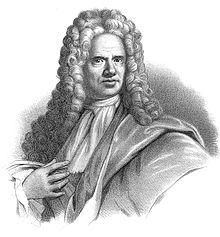Urban Hjärne
- Machine translation, like DeepL or Google Translate, is a useful starting point for translations, but translators must revise errors as necessary and confirm that the translation is accurate, rather than simply copy-pasting machine-translated text into the English Wikipedia.
- Do not translate text that appears unreliable or low-quality. If possible, verify the text with references provided in the foreign-language article.
- You must provide copyright attribution in the edit summary accompanying your translation by providing an interlanguage link to the source of your translation. A model attribution edit summary is
Content in this edit is translated from the existing Swedish Wikipedia article at [[:sv:Urban Hjärne]]; see its history for attribution. - You should also add the template
{{Translated|sv|Urban Hjärne}}to the talk page. - For more guidance, see Wikipedia:Translation.


Urban Hjärne (20 December 1641 – 10 March 1724) was a Swedish chemist, geologist, physician and writer. [1] [2]
Biography
He was born at Skworitz near Nyenschantz in Swedish Ingria. He was the son of vicar Erlandus Jonæ Hiærne (1596–1654) and Christina Tomasdotter Schmidt (1615–1682).
He was admitted in 1655 to the high school gymnasium in Dorpat. He went to Arva, where he studied until 1657. He entered Uppsala University in 1658. He began his medical education at Uppsala in 1661. For several years he visited Northern Europe's leading research center for medicine. He travelled to the Netherlands, England and France. In 1670, he became a doctor of medicine at Angers, France. In 1674 he settled as a physician in Stockholm where his practice primarily served the aristocracy.[3]
In 1669 he was elected a Fellow of the Royal Society. He was appointed first physician to the King Charles XI of Sweden in 1684 and was ennobled in 1689. He became assessor of the Board of Mines (Bergskollegium) in 1675. He became head of the Laboratorium Chemicum in 1683. [4] [5]
He was also the author of Stratonice, sometimes claimed to be the first Swedish novel, a partly autobiographical romance of seduction begun in 1665 and published in several parts, completed in 1668.[6]
In Sweden, Urban Hjärne is also known for his fight against witch trials. He was a member of the Witchcraft Commission in the Katarina witch trials during the Great noise in 1676, and is remembered as one of the members of the commission who started to feel scepticism toward witchraft and doubt the child witnesses, leading to the witnesses to be exposed as liars and the dissolution of the Katarina witch trials, the Witcraft Commission, and ultimately the entire witch hunt.[7]
Personal life
He built a research library of 3,500 books, one of the largest in Sweden. He married three times: first Maria Svahn, then Catharina Elisabeth Bergenhielm, and finally Elisabeth Carlsdotter. He died in Stockholm in 1724 and was buried at Bromma Church.
References
- ^ "Urban Hjärne". Historiesajten. Retrieved 1 April 2019.
- ^ Sten Lindroth. "Urban Hiärne". Svenskt biografiskt lexikon. Retrieved 1 April 2019.
- ^ "Hjärne Urban". Galileo Project. Retrieved 1 April 2019.
- ^ "Urban Hjärne". Bra Böckers lexikon. Retrieved 1 April 2019.
- ^ "Urban Hjärne". Svenskt Uppfinnare Museum. 31 March 2016. Retrieved 1 April 2019.
- ^ "Sweden". The Encyclopedia of Science Fiction. 8 October 2013. Retrieved 12 December 2013.
- ^ Urban Hiärne, urn:sbl:13625, Svenskt biografiskt lexikon (art av Sten Lindroth), hämtad 2022-09-16.
Other sources
- "Library and Archive". Royal Society. Retrieved 27 November 2012.
Further reading
- Pierer, Heinrich August (1859). Pierer's Universal-Lexikon der Vergangenheit und Gegenwart: Oder, Neuestes encyclopädisches Wörterbuch der Wissenschaften, Künste und Gewerbe. p. 416.
- Meyer, Hermann Julius (1850). Das grosse Conversations-Lexicon für die gebildeten Stände: In Verbindung mit Staatsmännern, Gelehrten, Künstlern und Technikern herausgegeben von J. Meyer. \Abth I, Bd.i-vi; vii, Abth.1,3–4;viii–xxiii;II,i-xv (in 45 volumes). Druck und Verlag des Bibliographischen Instituts. p. 887.
- v
- t
- e











